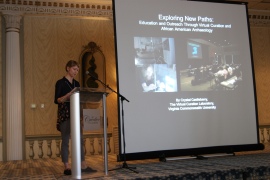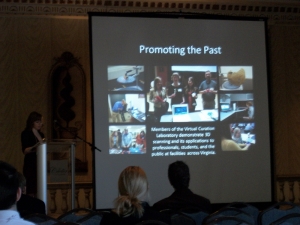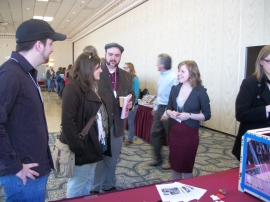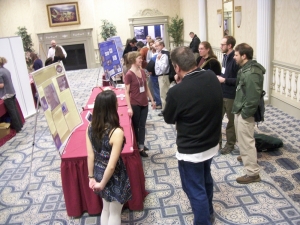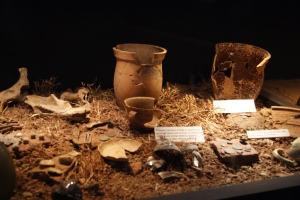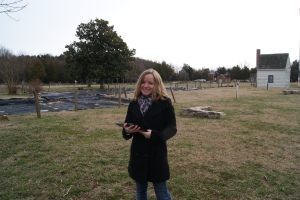 Last Friday I made my way to Virginia Beach, Virginia with my good friend and fellow student Mariana Zechini. We were traveling there to attend the Middle Atlantic Archaeological Conference and present research projects that we have been working on since the start of the fall semester. As we drove I found myself becoming more and more excited for what we were about to experience, but also nervous, as I was not sure what to expect. When we arrived we immediately met up with our professor, Dr. Bernard K. Means, and our fellow students and Virtual Curation Laboratory interns Courtney Bowles, Allen Huber, Rachael Hulvey, Crystal Castleberry, and Jamie Pham. After discussing our plans for the day, Mariana and I set out to see some presentations and check out the tables in the book room. After purchasing quite a few books from archaeologist Mike Madden (Dead Guy’s Books), we headed to Dr. Means’ presentation titled “Not Just Bells and Whistles? Changes in Technological Applications to Middle Atlantic Archaeology”. He discussed the use of technology in archaeology over time, leading to the 3-dimensional scanning and printing that the Virtual Curation Laboratory and similar organizations utilize. The paper was great, and I thought the information that he provided offered a great foundation to what the rest of us would be presenting later on.
Last Friday I made my way to Virginia Beach, Virginia with my good friend and fellow student Mariana Zechini. We were traveling there to attend the Middle Atlantic Archaeological Conference and present research projects that we have been working on since the start of the fall semester. As we drove I found myself becoming more and more excited for what we were about to experience, but also nervous, as I was not sure what to expect. When we arrived we immediately met up with our professor, Dr. Bernard K. Means, and our fellow students and Virtual Curation Laboratory interns Courtney Bowles, Allen Huber, Rachael Hulvey, Crystal Castleberry, and Jamie Pham. After discussing our plans for the day, Mariana and I set out to see some presentations and check out the tables in the book room. After purchasing quite a few books from archaeologist Mike Madden (Dead Guy’s Books), we headed to Dr. Means’ presentation titled “Not Just Bells and Whistles? Changes in Technological Applications to Middle Atlantic Archaeology”. He discussed the use of technology in archaeology over time, leading to the 3-dimensional scanning and printing that the Virtual Curation Laboratory and similar organizations utilize. The paper was great, and I thought the information that he provided offered a great foundation to what the rest of us would be presenting later on.
After lunch we all gathered to watch Crystal present her research on the use of 3D technology to promote the study of African-American heritage, titled “Exploring New Paths: Virtual Curation and African American Archaeology”. She did a wonderful job, and watching her made me very excited to present my paper the following day! We attended a few more sessions and met a number of professional archaeologists and students from other schools in the region. I was incredibly impressed and even moved by the amazing amount of support and encouragement that we – as students – received from everyone we met. I felt very at home there, and it was simply another one of those moments that made me grateful to be involved in such an incredible community of people.
The next morning I woke up bright and early and prepared for what I knew was a hugely important day for my career. My presentation was scheduled for 9:00 AM, so Mariana and I headed downstairs to the conference area about an hour early to meet up with our group. We all headed into our session, and before I knew it my turn to take the stage had arrived. I will admit I was quite nervous, but I was confident in my knowledge of the topic and knew my paper backwards and forwards, so I took a deep breath and began to speak.
My paper was called “Promoting the Past: The Educational Applications of 3D Scanning Technology in Archaeology”. I began by speaking about archaeological visualization and the introduction of 3D scanning and printing technology, followed by a discussion of how this technology can be utilized in various educational settings, including courses taught in anthropology, archaeology, osteology, and history. My research included giving lessons to students in high school and at the university level using both digital models of artifacts and plastic replicas, which Dr. Means, Mariana, Crystal and I have all been working on for a few months now. I honestly could not tell you how long my presentation was, but in what felt like no time at all, it was over and I stepped off the stage. My presentation was immediately followed by Allen’s, titled “Handing the Past to the Present: The Impact of 3D Printing on Public Archaeology”, and Rachel’s, which was called “New Dimensions: 3D Scanning of Iroquoian Effigy Sherds”. I was very impressed by both of their talks, and I thought we all complimented each other’s research very well! After Rachel finished her presentation we all gathered together and congratulations were given all around. The hardest part of the day was done!
We all grabbed lunch and headed back to the book room, where we had our 3D scanner and printer set up for a demonstration. While there I met a lot of people, and crossed paths with a few familiar faces. Laura Galke of Ferry Farm spent some time with us, as did Dave Muraca, who gave me confirmation of a very exciting development in my plans for this summer. I also ran into another friend from Ferry Farm, former intern Katie Lamzik! She presented a paper called “18th-Century Social Foodways at the Saunders Point Site”, which I very much enjoyed.
That afternoon we were joined by VCU student Stephanie King, who arrived just in time for the Small Finds poster session, which was organized by Laura Galke and Mara Kaktins and included posters by Courtney (“Moving between Reality as Virtual and Reality as Actual”), Crystal and Jamie (“Exploring New Paths: Research, Education, and Outreach Through 3D Archaeology”), Mariana (“Rocky Raccoon: The Application of 3D Technology to Zooarchaeology”), and the whole Virtual Curation Laboratory (“From the Actual to the Virtual to the Tangible: Virtual Curation and Small Finds”). I spent a good amount of time running around taking pictures of everyone, and I was incredibly impressed by their presentations. They were extremely professional and knowledgeable, and I was quite proud of all of them! I also made sure to stop by all of the other posters in the session, including Laura’s poster about the Washington Boys’ fashion accessories at Ferry Farm, and Mara’s poster about artifacts recovered from the First Philadelphia Almshouse.
After the poster session we all packed up and Mariana and I headed to the hotel restaurant to enjoy a lovely dinner before the MAAC Reception began that evening. The reception took place on the top floor of the hotel, which was quite beautiful! The VCU crew all congregated at one table, and MAAC President Bill Schindler began the party by welcoming everyone and thanking all who contributed to the conference. They then announced the winners of the student paper contest, which I was a candidate in. I eagerly held my breath as the graduate winner was announced, followed by the undergraduate winner… It was a tie between one other student (whose name I cannot recall, but I send my utmost congratulations)… and me! It’s hard to describe the joy I felt when I heard my name, but I can say it was one of the best feelings I have ever had. I felt so accomplished, and proud to know that my research left an impression on those who heard it.
The rest of the evening was spent getting to know the many archaeologists at the reception, discussing my work with other students, and catching up with some of the wonderful people that I met over the course of last summer… that amazing summer that led me here.
The next morning Mariana and I attended a few more sessions before making the long drive home. I am truly grateful to have had the opportunity to not only attend this event, but present at it, and I simply cannot wait until my next conference!
